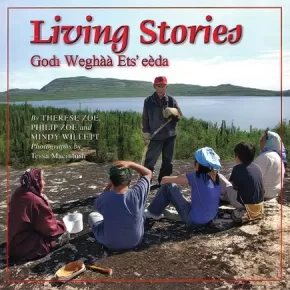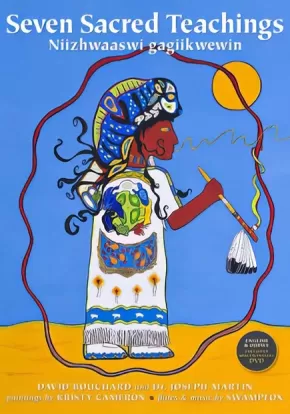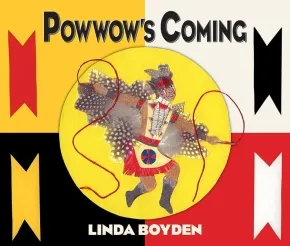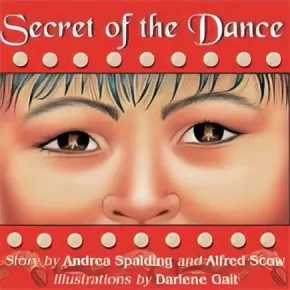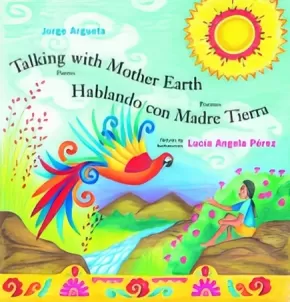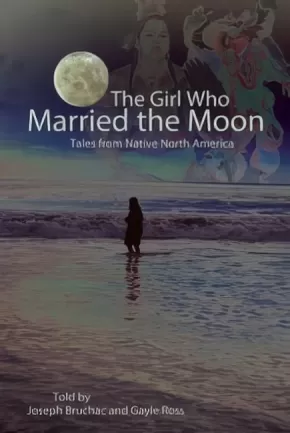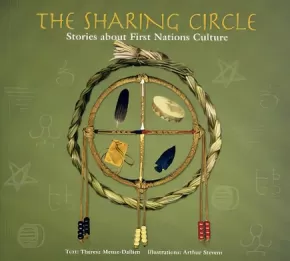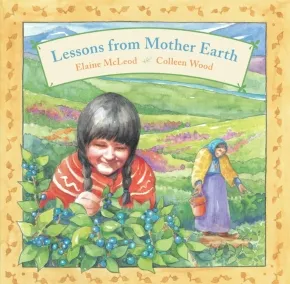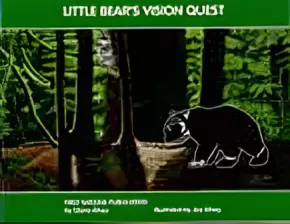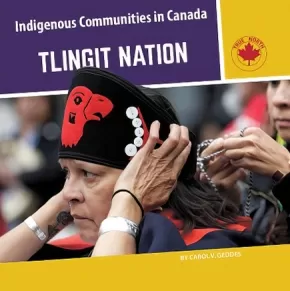
Indigenous Cultural Practices
196
-
208
of
208 Results;
Sort By
Go To
of 14
Living Stories: Godi Weghàà Ets' eèda
$16.95
Artists:
Format:
Hardcover
Text Content Territories:
Indigenous Canadian; First Nations; Dene; Tlicho (Dogrib);
ISBN / Barcode: 9781897252444
Synopsis:
Synopsis:
The third title in "The Land is Our Storybook" series, by and about the people of the Northwest Territories, for readers at grade 4 - 7 level.
In Living Stories, Therese Zoe translates the stories and traditional wisdom of Tlicho Elders Philip Zoe and Elizabeth Chocolate.
Therese Zoe is a Tlicho woman from Gamèti in the Northwest Territories. She is a community health representative, a mother and grandmother, as well as a champion of ancestral skills and stories. In Living Stories, Therese shares her love for her community and translates the sacred stories and traditional wisdom of her brother-in-law, Philip Zoe, and his sister, Elizabeth Chocolate. As Therese writes, "You might look at our lands and think they are empty, but we do not go hungry. The land gives us our food and our shelter. It holds our stories and our histories. It gives us everything we need."
Join Tlicho young people, Shelinda, Forest, and Bradley, as they learn about making dry-fish, bows and arrows, and birch-bark baskets; the practices of old-time healers; as well as the sacred stories that tell the history of the Tlicho people. Some of the stories Philip relates in this book have never been written down before - his versions of sacred stories are a gift to young readers across Canada, to be used wisely. The Tlicho Nation was the first in the Northwest Territories to gain self-government. With Elders such as Philip and Elizabeth passing along their traditional wisdom to the young, as well as knowledge gained since the Tlicho first encountered European peoples, the Tlicho are showing how they are, "strong like two people."
Reviews
"Living Stories is a heartfelt tribute to the culture of the Tlicho or Dogrib nation. . . All of the information is presented in a very personal way so that young readers unfamiliar with the first nations culture in the north can realize this is a real way of life for some people, not something from 'long ago and far away'. . . Photographer Tessa Macintosh, a southerner whose children are Tlicho, has done a wonderful job of including pictures of the land and the people, some posed to represent the subject under discussions, many in cheerful candid shots." — CM Magazine
Educator & Series Information
This book is part of the "The Land Is Our Storybook" series, which considers the diverse lands and cultures of Canada's Northwest Territories. Told in a uniquely diverse range of northern voices, with a child-centred approach, books in the series highlight each official Aboriginal language group in the NWT, revealing a richly textured picture of life in the North-on the trapline, around the campfire, in communities, at school, and within the outdoor school that is the land itself. The series celebrates the seasons, ages, genders, traditional activities, and communities of the NWT.
The stories are illustrated by the striking images of acclaimed northern photographer, Tessa Macintosh and depict the similarities in lifestyle between children of the North and South, as well as the marked cultural differences, and highlight the special relationship these First Nations people have with the land and how they are adapting to rapid change while remaining connected to the land. Images of the landscape and animals within it, of trapping, hunting, fishing, and bannock baking sit alongside pictures of children at school, swimming at recreation centres, and reading in libraries. Here is modern northern culture painted beautifully: a complex mix of the new and the old.
These wonderful books, written with a variety of provincial and territorial curricula in mind, are specially designed for the classroom and include special features such as glossaries relating details on animals biology and cultural definitions, regional and language maps. The text of the stories also have sidebars such as Our Stories, which contain the stories of the people and language group featured, and Our Words, which highlight words in the featured language that are important to the story.
Recommended Grade Level: 4-7
This resource is also available in French: Nos histoires sont vivantes
Additional Information
32 pages | 8.00" x 8.00" | colour photographs and illustrations throughout
Seven Sacred Teachings: Niizhwaaswi gagiikwewin
$24.95
Artists:
Format:
Hardcover
Text Content Territories:
Indigenous Canadian;
Reading Level: N/A
ISBN / Barcode: 9780978432720
Synopsis:
Synopsis:
Seven Sacred Teachings is a message of traditional values and hope for the future. The Teachings are universal to most First Nation peoples. These Teachings are seen in school communities from coast to coast across North America. They are a link that ties all Native, Inuit and Métis communities together.
The seven teachings include: respect, humility, love, truth, honesty, wisdom and courage. The stories in the book provide an example of how each teaching came to be.
Educator Information
Seven Sacred Teachings has been produced in several languages. This edition is in English and Ojibwe.
This resource is also available in French: Les Sept enseignements sacrés
Jenneli's Dance (8 in Stock)
$12.95
Artists:
Format:
Paperback
Text Content Territories:
Indigenous Canadian; Métis;
ISBN / Barcode: 9781894778619
Synopsis:
Synopsis:
Jenneli is a shy young girl who feels that she is nothing special, until she learns about the Métis Red-River Jig from her grandma. One day, Grandma Lucee enters her into a jigging contest. Jenneli's Dance is a story that instills a sense of pride in the Métis culture, and deals with low self-esteem.
Additional Information
44 pages | 7.94" x 9.02"
niwechihaw / I Help
$12.99
Artists:
Format:
Paperback
Text Content Territories:
Indigenous Canadian; First Nations; Cree (Nehiyawak);
ISBN / Barcode: 9781773061160
Synopsis:
Synopsis:
This sweet, simple story looks at a very special relationship. A young boy goes for a walk with his kohkom, or grandmother, listening, picking, praying, eating... just as she does. In doing so, he begins to learn the rich cultural traditions and values of his Cree heritage.
Caitlin Dale Nicholson’s acrylic-on-canvas illustrations portray the close relationship between the boy and his grandmother and the natural beauty of the bush. Her text has been translated into Cree by Leona Morin-Neilson, who was also the inspiration for the story and collaborated with her on this work.
Educator & Series Information
Recommended Ages: 4-7
Delivered in a dual-language format of Cree (y-dialect) and English.
This book is part of the Nôhkom series.
Recommended for Grades K-1 for the following subject areas: English Language Arts, Indigenous Language Studies, Social Studies, Science and Nature, Visual Arts.
Authenticity Note: Leona Morin-Neilson (Métis-Cree) is a Cree teacher and the inspiration behind this book. She collaborated with the author to create this work. Leona Morin-Neilson teaches Cree at the “Power of Friendship” Aboriginial Headstart program in Prince George, British Columbia, and at the University of Northern British Columbia. She also teaches people in her community about traditional plants and how they can be used for medicinal purposes.
Because of the collaboration between Leona and the author, and Leona's Cree translation, this book has been labeled as containing Authentic Indigenous Text. It is up to readers to determine if this work is authentic for their purposes.
Additional Information
24 pages | 8.50" x 12.25"
Powwow's Coming
$29.95
Artists:
Format:
Hardcover
Text Content Territories:
Indigenous American;
ISBN / Barcode: 9780826342652
Synopsis:
Synopsis:
This is a celebration of the contemporary powwow, which provides a rhyming verse to attract young children to the fun one can enjoy at a powwow. Boyden skillfully takes the main points of a powwow and creates anticipation in the charming verse.
Powwow's coming, hear the beat?
Powwow's coming, dancing feet.
Powwow's coming, hear the drum?
Powwow's coming, everyone!
Frustrated as a schoolteacher not being able to find good instructional materials on American Indians, Linda Boyden has bypassed the tired stereotype of Indians on horseback or hunting game and placed them in today's setting of a powwow.
Powwow's Coming provides children with a foundation for understanding and celebrating the enduring culture and heritage of American Indians. Boyden's exquisite cut-paper collage and engaging poem visually place readers within the scenes of a contemporary Native American community while offering a thoughtful look at powwows and their meanings to the Native participants.
Secret of the Dance
$12.95
Artists:
Format:
Paperback
Text Content Territories:
Indigenous Canadian; First Nations; Kwakwaka'wakw (Kwakiutl); Kwicksutaineuk ;
ISBN / Barcode: 9781554691296
Synopsis:
Synopsis:
"Many years ago, when the world and I were younger, my family defied the government."
A boy will never forget witnessing a forbidden Potlatch. In 1935, a nine-year-old boy's family held a forbidden Potlatch in faraway Kingcome Inlet. Watl'kina slipped from his bed to bear witness. In the Big House masked figures danced by firelight to the beat of the drum. And there, he saw a figure he knew. Aboriginal elder Alfred Scow and award-winning author Andrea Spalding collaborate to tell the story, to tell the secret of the dance.
Educator Information
"This story tells of a time when potlatches, ceremonial dancing and the wearing of regalia and masks were forbidden by Canadian law. A young boy, based on Judge Alfred Scow's boyhood story, witnesses the last secret potlatch of this community before the threat of imprisonment caused them to stop dancing." - FNESC, "BC First Nations Land, Title, and Governance"
Additional Information
32 pages | 9.00" x 9.00"
Talking With Mother Earth (14 in Stock) - ON SALE
$14.00 $18.95
Artists:
Format:
Hardcover
Text Content Territories:
Indigenous Central American; Nahuas;
ISBN / Barcode: 9780888996268
Synopsis:
Synopsis:
Raw, honest and powerful, these moving bilingual poems by noted Salvadoran poet Jorge Argueta explore a young native boy's connection to Mother Earth and how he is healed from the terrible wounds of racism he has endured. Tetl has learned from his grandmother about the spirituality of his ancestors, about how they viewed the earth as alive with sacred meaning. This helps him move from doubt and fear, created by the taunts of other children, to self-acceptance and a discovery of his love for nature.
Mountains, wind, corn and stones all speak to Tetl, almost seeming to vibrate with life. He feels deep roots in them and, through them, he learns to speak and sing. They reveal his Nahuatl self and he realizes that he is special, beautiful and sacred.
These gripping poems have something to teach us all, perhaps especially those who have been either intentionally or casually cruel or racist, as well as those who have been the victims of racism.
Crudos, honestos e impactantes, estos conmovedores poemas bilingües por el aclamado salvadoreño Jorge Argueta exploran la relación de un joven nativo con la Madre Tierra y de como fue curado de las terribles heridas causadas por el racismo que ha tenido que aguantar. Tetl ha aprendido de su abuela sobre la espiritualidad de sus ancestros, sobre como ellos veían la tierra como un ser vivo con un sentido sagrado. Esto lo ayuda a pasar de la duda y el miedo, creado por las burlas de los otros niños, a la aceptación de sí mismo y al descubrimiento de su amor por la naturaleza.
La montañas, el viento, el maíz y las piedras le hablan a Tetl, parece casi que vibran de vida. El siente profundas raíces en ellos, a través de ellos, y aprende a hablar y cantar. Ellos le revelan su parte Náhuatl y él se da cuenta de que es especial, bello y sagrado.
Estos poemas apasionantes tienen algo que enseñarnos a todos, quizás especialmente a aquellos que intencionalmente o sin quererlo han sido crueles o racistas, como también a aquellos que a su vez han sido víctimas del racismo.
Additional Information
36 pages | 8.94" x 9.56"
The Girl Who Married the Moon
$18.95
Format:
Paperback
Text Content Territories:
Indigenous American; Native American;
ISBN / Barcode: 9781555915667
Synopsis:
Synopsis:
This collection of traditional stories explores the significance of a young girl's rite of passage into womanhood. Each of these stories originated in the oral tradition and have been carefully researched. Joseph Bruchac, author of the best-selling Keeper's of the Earth series, and noted storyteller, has been entrusted with stories from elders of other native nations which ensures that the stories collected in The Girl Who Married the Moon are authentic.
The book is broken into four sections, signifying the importance of the number four to Native peoples, and provides an opportunity to hear from a wide variety of Native American tribal nations. These nations have offered to share their stories with their blessing, to celebrate the traditional ways.
The Sharing Circle (Meuse)
$13.95
Artists:
Format:
Paperback
Text Content Territories:
Indigenous Canadian; First Nations;
ISBN / Barcode: 9781551094502
Synopsis:
Synopsis:
Matthew loves to play games with his friends and share his toys with them. But most of all he loves to share the special treasures that remind him of his First Nations culture. Perhaps his favourite treasure is the medicine pouch that his grandfather made especially for him. This is where he keeps many of his other treasures, including the sacred herbs his mother gave him. Matthew uses the herbs to remind him to be grateful for everything that nature gives us. Another special gift is the eagle feather from his father. Matthew knows that the eagle is a symbol of the spiritual strength of his culture. But there is one other gift that has a special place in Matthew's heart. It is the dream catcher that Matthew gave to his friend Dustin to help him not have bad dreams.
The Sharing Circle is a collection of seven stories about First Nations culture and spiritual practices: The Eagle Feather, The Dream Catcher, The Sacred Herbs, The Talking Circle, The Medicine Wheel, The Drum, and The Medicine Pouch. Researched and written by Mi'kmaw children's author Theresa Meuse-Dallien, and beautifully illustrated by Mi'kmaw illustrator Arthur Stevens, this book will engage and inform children of all ages.
Educator & Series Information
Recommended for ages 4 to 8.
This book is part of the Indigenous Knowledge Series.
Additional Information
52 pages | 9.00" x 8.00"
Lessons From Mother Earth
$10.99
Artists:
Format:
Paperback
Text Content Territories:
Indigenous Canadian; First Nations; Tutchone; Northern Tutchone; Na-Cho Nyak Dun;
ISBN / Barcode: 9780888998323
Synopsis:
Synopsis:
This gentle story demonstrates the First Nations' tradition of taking care of Mother Earth.
Tess has visited her grandmother many times without really being aware of the garden. But today when they step out the door, Tess learns that all of nature can be a garden. And if you take care of the plants that are growing, if you learn about them - understanding when they flower, when they give fruit, and when to leave them alone - you will always find something to nourish you.
At the end of the day, Tess is grateful to Mother Earth for having such a lovely garden, and she is thankful for having such a wise grandma.
Elaine McLeod's poetic text and Colleen Wood's gentle watercolors combine to make Lessons from Mother Earth a celebration of nature and life.
Educator Information
Curriculum Connections: Social Studies, Science and Nature.
Additional Information
24 pages | 8.80" x 8.80"
Thirteen Moons On Turtle's Back: A Native American Year Of Moons
$12.49
Format:
Paperback
Text Content Territories:
Indigenous American; Native American;
ISBN / Barcode: 9780698115842
Synopsis:
Synopsis:
To many Native Americans, the 13 cycles of the moon represent the changing seasons and the passage of time. Each moon has its own special name that, while varying among the tribal nations, is consistent with the legend that the 13 scales on Old Turtle's back hold the key to these moons. The authors present 13 poems that take readers through the year, from the "Moon of Popping Trees"--when the "cottonwoods crack with frost"--to the "Big Moon" of the Abenakis. The book's effective design consists of verses in vertical columns at the left of each spread, with the remainder occupied by Locker's ( Family Farm ; Catskill Eagle ) typically lush artwork. His oil paintings are eye-catching in their depth of color reflecting dramatic seasonal changes. Trees, skies and woodland creatures are rendered in vivid hues that combine to produce an enthralling vision. This unusual and intelligent book is an exemplary introduction to Native American culture with its emphasis on the importance of nature.
Additional Infromation
32 pages | 8.00" x 10.25"
La Quete Spirituelle de Petit Ours
$15.00
Artists:
Format:
Paperback
Text Content Territories:
Indigenous Canadian; First Nations;
ISBN / Barcode: 9781894114051
Synopsis:
Synopsis:
Little Bear is preoccupied with himself and overtures of friendship by the other animals are quickly rebuffed with taunting and insults. So Grandfather, knowing what to do, sends Little Bear to the island to search his heart. Traditional remedies sometimes take time, a long time. In isolation Little Bear comes face to face with himself and gains insight. In Little Bear, youngsters will see the transformation of an aloof self-centered spirit into a person fit to participate in the communal life of the village, one to whom Grandfather lovingly says, "Welcome home, Little Bear, welcome home." Joe Silvey's illustrations richly complement the story.
(French Version)
Educator Information
This resource is also available in English: Little Bear's Vision Quest.
Indigenous Communities in Canada: Tlingit Nation
$14.95
Format:
Paperback
Text Content Territories:
Indigenous Canadian; First Nations; Tlingit;
ISBN / Barcode: 9781773086408
Synopsis:
Synopsis:
A book about the Tlingit Nation.
Educator & Series Information
This book is part of the Indigenous Communities in Canada series.
Additional Information
24 Pages
Sort By
Go To
of 14

